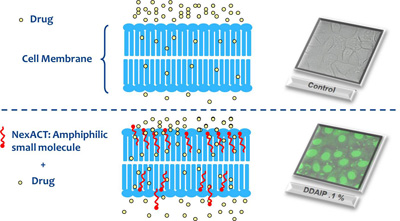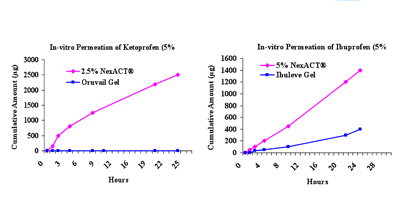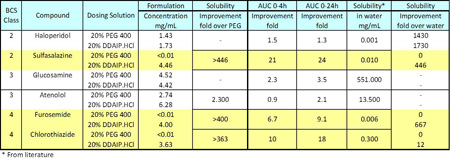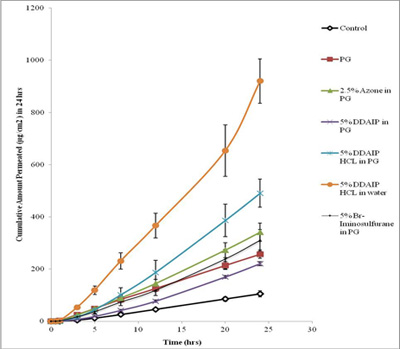A permeation enhancing technology developed by Apricus Bioscience and NexMed USA has recently been used in a drug approved by Health Canada. Richard Martin, Bassam Damaj and Dan Frank explain its use in optimising pharmacokinetics
The NexACT technology developed by NexMed consists of proprietary chemical entities that improve solubility and permeation of drugs through tissue and cell membranes resulting in enhanced drug permeation1,2 and/or oral absorption. These permeation enhancers temporarily change the permeation dynamics of the lipid bilayer and loosen the tight junctions between the cells, which enables an increased absorption of drug into the systemic circulation or an increase in local absorption (see Figures 1a & b).

Fig. 1b: Mechanism of enhanced permeation. Real-time confocal microscopy of the DDAPI on uptake of Green Nucleic Acid Stain compared with control
The NexACT multi-route drug delivery platform consists of more than 100 different skin permeation enhancer molecules that could be used in drug formulation to increase permeation and achieve higher bioavailability.
The permeation enhancer molecules are alkyl N,N-dimethylaminoacetates (esters of fatty alcohols and amino acids) and N,N-dimethylalkanol esters of alkanoic acids (esters of fatty acids and amino alcohols). Chemically, they are amphiphilic molecules. Their building blocks consist of an amino acid and a lipid; both structures are part of the human biological building blocks. The latter characteristics make the NexACT enhancers and their metabolite products easily recyclable into the human biochemistry. NexACT-88 (dodecyl-2-N,N-dimethylamino propionate hydrochloride, or DDAIP.HCl) is the permeation enhancer used in the development and approval of Vitaros and other late stage commercial development programmes (Figure 2).

Figure 2: DDAIP.HCl structure, properties and toxicology
Structure and properties
Formula: C17H36ClNO2 (321.93 gmol-1)
Physical Properties: White crystalline solid with melting point 88-93°C
Log D (o/w) 0.99; Log P (o/w) 4.37; pKa 4.87
Toxicology and safety
Topical NOEL 50mg/kg/day (NDA/NDS Tox studies up to 5% w/w)
Subcutaneous NOEL 10mg/kg/day (6 month rat study)
Oral LD50 >5g/kg (rat-limit test)
IV LD50 >750mg/kg (mice)
The permeation enhancer molecules are designed to be non-toxic and readily metabolised by the body into non-toxic, naturally occurring products. Esterases on the cell surface and in circulating blood plasma hydrolyse DDAIP into dodecanol and N,-N-dimethylalanine, which are further processed by the body and converted to alanine and lauric acid.
The safety of DDAIP.HCl has been addressed in a series of acute and chronic preclinical toxicity studies in different animal species. Results from these studies show that DDAIP.HCl is safe and well tolerated. Further oral safety studies are also expected.
Clinical safety studies in humans show that topical application of DDAIP.HCl on the skin and mucous membranes is well tolerated. More than 5,000 patients have been exposed with at least 20,000 applications. The most advanced product utilising the technology is Vitaros, an alprostadil-based cream that was recently approved in Canada and is currently under review in Europe. Vitaros is the only approved treatment that will be available to the entire population of erectile dysfunction patients.
bioavailability enhancement
DDAIP can increase solubility of hydrophobic molecules and non-covalently binds to small molecules or protein active pharmaceutical ingredients (APIs) in various ways. These include hydrophobic interactions, hydrogen bonds and salt bridges. DDAIP.HCl is simply added as an excipient to the formulation, and it does not result in chemical modification of the API or in a new chemical entity.
This technology has additional potential to form micelles (CMC 0.15%) and act as a surfactant. It is also important to mention that increased drug within the cells or in systemic circulation is not due to inhibition of P-glycoprotein (P-gp IC50>10 mM).
Transdermal delivery: The enhancing permeation ability of DDAIP.HCl has been tested on several example drugs in Franz cells assay using human (fresh) skin from elective surgery or cadaver skin. For example, the flux rates for ketoprofen and ibuprofen are shown in Figure 3.

Figure 3: Transdermal flux
Depending on the molecule of interest and its interactions with the NexACT molecules, different kinetics of permeation can be observed. For ketoprofen, comparing the Oruvail gel with and without NexACT showed more than a 50-fold enhanced permeation, while ibuprofen Ibuleve gel showed more than a three-fold enhanced permeation at 24h. More than 50 molecules with different chemical structures and therapeutic indications, spanning a wide range of molecular weights (100-700) and clogP (-1 to 6) have been evaluated to date. Data from these experiments indicate that permeation enhancement has been detected in all cases with a varying degree of permeability increase, suggesting the versatility of the technology.
Oral delivery: Data has been generated on several ‘model’ drug formulations, demon-strating the potential of the technology in developing a wide range of highly bioavailable oral products. The biopharmaceutical classification system (BCS) developed by Professor Gordon Amidon, from the College of Pharmacy at the University of Michigan, to classify drugs based on their solubility and permeability separates drugs into four quadrants.3,4 Class 1 consists of high solubility and high permeability compounds, Class 2 is low solubility and high permeability, Class 3 is high solubility and low permeability and Class 4 is low solubility and low permeability.
To test the effect of DDAIP.HCl on solubility and permeability of drugs belonging to different class systems, two compounds from Class 2 (haloperidol, sulfasalazine), 3 (glucosamine, atenolol) and 4 (furosemide, chlorothiazide) were included in the study. All drugs were tested via an oral gavage in rat at 30mg/kg (5mg/mL formulation). After centrifugation, solubility in various formulations and plasma levels were measured by LC/MS-MS.
The results show that DDAIP.HCl clearly improves solubility of compounds when compared with water or a 20% PEG 400 vehicle. This improvement is also reflected in enhanced blood levels of drug in rats. The most beneficial effect of DDAIP.HCl was observed with compounds that belong to Class 2 and 4. Solubility improvements of 400-fold and AUC improvements of over 20-fold were achieved compared with the PEG formulations. This data shows that formulations with DDAIP.HCl can significantly improve the oral delivery of some small molecules by positively affecting their solubility and subsequently their absorption. This is especially useful for promising drug candidates that did not pass the solubility test criteria.
Buccal delivery: The permeation of ondansetron.HCl, an antiemetic compound, was measured in Franz cells using porcine buccal tissue (Figure 4).5 Various enhancers were evaluated and it was found that 5% DDAIP.HCl in water was the most effective enhancer/vehicle formulation for transbuccal delivery of ondansetron.HCl and that cell viability was maintained. This is a clear advantage of the NexACT technology since most known permeation enhancers are very hydrophobic and require co-solvents .

Table 1: Oral parameters
Other routes: Since many routes of administration also operate on the basic principle of passive permeation, similar enhancements would be expected. Other routes that are currently being investigated are nasal, subcutaneous, rectal and pulmonary delivery.
technology improvements
The first generation of the technology utilised the free base of the alkyl N,N-dimethyl aminoacetates. The second generation of the technology explored different salt forms to improve water solubility, ease of cGMP manufacturing and high purity specifications. Consequently, the end product is a solid with prolonged stability and ease of handling.
Finally, the third generation of the technology is the optically pure active enantiomer, which will allow more potency and subsequently lower excipient concentration into final drug formulations.
In conclusion, the advantages and safety of the NexACT technology have been validated clinically and it is now incorporated in an approved product. It represents a major breakthrough in the delivery of difficult-to-absorb compounds. Availability of this technology and its wide application for other drugs could help in the development of compounds that would otherwise have been abandoned during the discovery process; it could also be used to extend patent life of existing drugs via pharmaceutical compositions containing this technology.

Figure 4: Buccal delivery – permeation of ondansetron.HCl, an antiemetic compound, measured in Franz cells using porcine buccal tissue. Various enhancers were evaluated and it was found that 5% DDAIP.HCl in water was the most effective (Ref 5)
Richard Martin and Dan Frank are from Apricus Biosciences, Inc San Diego, CA 92121, USA
Bassam Damaj is with NexMed (USA), Inc San Diego, CA 92121, USA
References:
1. J. Hadgraft, Skin Pharmacol Appl Skin Physio 2001:14 (Suppl 1): 72-81.
2. Wolka et. al., Int. J. Pharm. 2004:217 (1-2):5-10.
3. WHO List of Essential Drugs, 16th ed., revised March 2010.
(www.who.int/medicines/publications/essentialmedicines/Updated_sixteenth_adult_list_en.pdf)
4. Amidon, G. L.; Lennernas, H.; Shah, V. P.; Crison, J. R. A, Pharm. Res. 1995, 12, 413-420.
5. Figure 4 taken from: Hu, L., Damaj, B.B., Martin, R., Michniak-Kohn, B.B., Int. J. Pharm. 2011, 404(1-2), 66-74.




